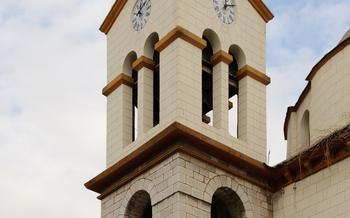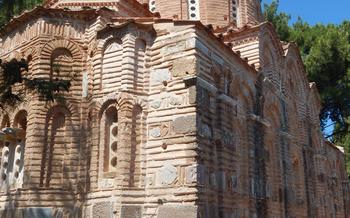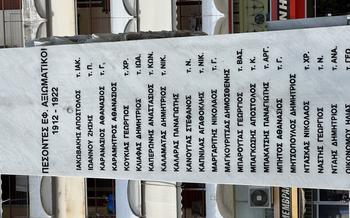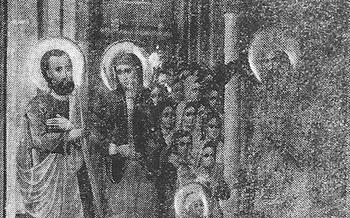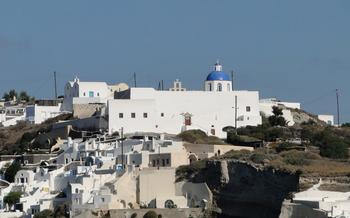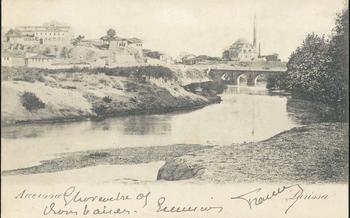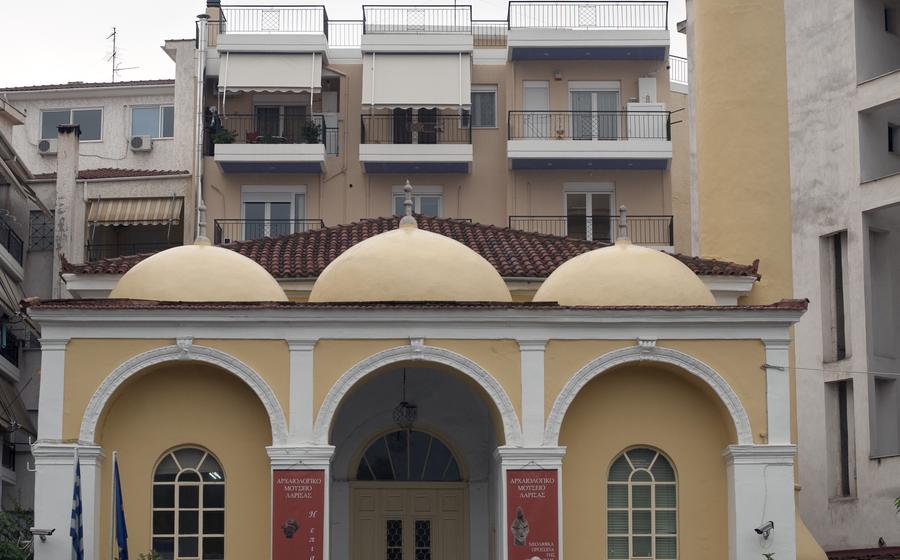
Church of Saint Nicholas, Larissa
- The Church of Saint Nicholas in Larissa: A Masterpiece of Byzantine Architecture
- Historical and Cultural Significance:
- Architectural Marvel
- Interior Splendor
- The Iconostasis
- The Hagiographies
- The Altar and Sanctuary: A Sacred Space
- The Crypt
- The Churchyard: A Place for Contemplation and Reflection
- Restoration and Preservation: A Labor of Love
- Religious Services and Ceremonies
- Local Traditions and Customs
- Community and Social Gatherings
- The People of Saint Nicholas
- Insider Tip:
The Church of Saint Nicholas in Larissa: A Masterpiece of Byzantine Architecture
In the heart of Larissa, one of Greece's most charming cities, stands the magnificent Church of Saint Nicholas, a testament to the city's rich cultural and religious heritage. Erected in the 10th century during the Byzantine era, this architectural marvel has stood the test of time, captivating visitors with its intricate design, awe-inspiring frescoes, and profound religious significance.
The church is dedicated to Saint Nicholas, the patron saint of sailors, merchants, and children, who holds a special place in the hearts of the Greek Orthodox faithful. Throughout the centuries, the Church of Saint Nicholas has served as a beacon of faith, a place of worship, and a symbol of the city's enduring spiritual legacy.
Historical and Cultural Significance:
The Church of Saint Nicholas holds immense historical and cultural significance in the city of Larissa. It serves as a testament to the city's rich religious and cultural heritage. The church is dedicated to Saint Nicholas, a revered figure in Greek Orthodox tradition, known for his generosity, compassion, and protection of sailors and travelers. Saint Nicholas is deeply embedded in Greek culture, and his name is often associated with miracles and acts of kindness. The church serves as a pilgrimage site for many faithful, who come to pay homage to the saint and seek his intercession. Over the centuries, the church has become a symbol of Larissa's spiritual identity and a source of pride for its people. It has played a vital role in shaping the city's religious traditions, customs, and festivals, contributing to the unique cultural fabric of Larissa.
Architectural Marvel
The Church of Saint Nicholas in Larissa stands as a testament to the grandeur and artistry of Byzantine architecture. Its exterior boasts a majestic dome that dominates the skyline, adorned with intricate carvings and vibrant colors. The bell tower, a symbol of strength and faith, rises beside the dome, its delicate arches and decorative elements adding to the church's charm.
The church's façade showcases intricate carvings that depict scenes from the Bible and the life of Saint Nicholas. These carvings, a testament to the skill and devotion of Byzantine artisans, bring the stories of faith and devotion to life. The church's entrance, framed by an elegant archway, invites visitors to step into a world of spirituality and wonder.
Inside, the church's grandeur continues. The nave, the central part of the church, is supported by a series of columns adorned with intricate capitals. These columns, with their alternating colors and patterns, create a sense of rhythm and movement, leading the eye towards the altar.
The aisles, which flank the nave, provide additional space for worshipers to gather. They are separated from the nave by a series of arches, which echo the shape of the dome and create a sense of unity and harmony.
The apse, the most sacred part of the church, is located at the eastern end of the building. It houses the altar, where the Eucharist is celebrated, and is adorned with a stunning mosaic depicting Jesus Christ surrounded by angels.
Interior Splendor
Stepping inside the Church of Saint Nicholas is like entering a realm of exquisite artistry and divine inspiration. The church's interior is a symphony of colors, shapes, and symbols that captivate the senses and transport visitors to a higher realm.
The nave, with its soaring columns and elegant arches, creates a sense of awe and grandeur. The aisles, adorned with intricate carvings and delicate moldings, lead the eye towards the apse, where the altar stands as the focal point of the church's interior.
The walls and ceilings are adorned with stunning frescoes, a testament to the skill and devotion of Byzantine artists. These frescoes depict scenes from the Bible, the life of Saint Nicholas, and other saints, bringing to life the stories and teachings of Christianity.
The vibrant colors, the expressive figures, and the intricate details of the frescoes create a visual feast that is both aesthetically pleasing and spiritually uplifting. Each fresco tells a story, conveying theological messages, moral lessons, and the essence of the Orthodox faith.
The harmonious blend of architecture, art, and symbolism in the interior of the Church of Saint Nicholas creates a sacred space that invites contemplation, prayer, and a deep connection with the divine.
The Iconostasis
A striking feature of the Church of Saint Nicholas is its magnificent iconostasis, a carved wooden screen that separates the nave from the sanctuary. This elaborate barrier is adorned with intricate iconography, depicting biblical scenes and the lives of saints. The icons are arranged in tiers, with the central panel featuring a depiction of Christ Pantocrator, surrounded by images of the Virgin Mary, John the Baptist, and the Twelve Apostles. The vibrant colors, detailed brushwork, and symbolic representations make the iconostasis a true masterpiece of Byzantine art.
The iconostasis serves as a visual representation of the separation between the earthly and heavenly realms. It also plays a significant role in Orthodox worship, as it conceals the altar and sanctuary during certain parts of the liturgy. The icons on the screen serve as a reminder of the saints and their role as intercessors between God and humanity, inviting the faithful to contemplate their lives and teachings.
The Hagiographies
The art of hagiography holds a prominent place in Byzantine culture, and the Church of Saint Nicholas boasts a collection of exquisite hagiographies dedicated to the life and miracles of Saint Nicholas. These hagiographies are not mere decorative elements but serve as powerful tools for conveying theological messages and inspiring the faithful.
Each hagiography is meticulously crafted, depicting scenes from Saint Nicholas' life with intricate detail and vivid colors. The artists used symbolism and allegory to convey deeper meanings, inviting viewers to contemplate the saint's virtues and the significance of his actions.
One particularly striking hagiography portrays Saint Nicholas saving a ship caught in a fierce storm. The waves crash against the vessel, threatening to engulf it, while the terrified sailors cling to the rigging for dear life. Saint Nicholas, depicted as a majestic figure with a commanding presence, stands at the helm, radiating divine power. With outstretched hands, he calms the tempest, restoring peace and tranquility to the sea.
Another hagiography depicts Saint Nicholas rescuing three young girls from a life of prostitution. The girls, symbolized by three golden apples, were about to be sold by their impoverished father when Saint Nicholas intervened. He appears in the guise of a wealthy merchant, discreetly placing a bag of gold coins in the father's house, thus saving the girls from their desperate fate.
Through these hagiographies, the Church of Saint Nicholas invites visitors to delve into the life of Saint Nicholas, to witness his miraculous interventions, and to draw inspiration from his unwavering faith and compassion.
The Altar and Sanctuary: A Sacred Space
The altar, the most sacred space within the Church of Saint Nicholas, is where the Eucharist, the central sacrament of the Orthodox faith, is celebrated. It is elevated and separated from the rest of the church by a beautifully carved iconostasis. The altar is adorned with elaborate decorations, including intricate carvings, precious metals, and shimmering fabrics.
Behind the altar lies the sanctuary, a restricted area reserved exclusively for the clergy during religious services. Within the sanctuary, one can find the bishop's throne, symbolizing his authority and leadership in the church. The sanctuary also houses the sacristy, where sacred vessels and vestments used in the liturgy are stored.
The altar and sanctuary together create a mystical and awe-inspiring atmosphere, emphasizing the profound significance of the Eucharist and the sacredness of the space. They stand as a testament to the deep reverence and devotion that permeate the Orthodox Christian faith.
The Crypt
Beneath the Church of Saint Nicholas lies a hidden treasure—a crypt, a subterranean chamber that holds historical significance. The crypt is a testament to the rich history of the church and the community it serves. While its exact origins are shrouded in mystery, it is believed to date back to the early days of the church's construction.
The crypt's architecture is as intriguing as its history. Its vaulted ceiling, supported by sturdy columns, creates a sense of awe and reverence. The walls are adorned with intricate carvings and frescoes, some of which have faded with time but still retain their beauty. The crypt's atmosphere is serene and contemplative, inviting visitors to reflect on the passage of time and the lives of those who have gone before them.
Throughout history, the crypt has served various purposes. It was initially used as a burial place for important religious figures and community leaders. The remains of these individuals were laid to rest in stone sarcophagi, some of which can still be seen today. The crypt also functioned as a place of refuge during times of war or persecution, providing a safe haven for those seeking shelter.
Today, the crypt is open to visitors who wish to explore the hidden depths of the Church of Saint Nicholas. It offers a glimpse into the past, reminding us of the rich history and traditions that have shaped this sacred space.
The Churchyard: A Place for Contemplation and Reflection
Surrounding the Church of Saint Nicholas is a tranquil and serene churchyard, inviting visitors to pause, contemplate, and soak in the spiritual ambiance. The well-maintained gardens and pathways add to the charm of this sacred space, creating an environment conducive to reflection and introspection. Within the churchyard, visitors can find solace amidst the lush greenery and colorful blooms, offering a respite from the bustling city.
The churchyard also serves as a place for remembrance, where loved ones are laid to rest. Adorned with intricate carvings and epitaphs, the tombstones narrate the stories of those who have contributed to the rich history of Larissa. Visitors can pay their respects and remember those who have passed on, connecting with the past and reflecting on the transience of life.
Whether seeking spiritual contemplation, a moment of tranquility, or a connection with the past, the churchyard of the Church of Saint Nicholas offers a sanctuary for visitors to find solace and inspiration amidst the vibrant city of Larissa.
Restoration and Preservation: A Labor of Love
Over the centuries, the Church of Saint Nicholas has undergone several restoration and preservation efforts to maintain its grandeur and historical significance. The church's resilient structure has withstood the test of time, but natural wear and tear, as well as the ravages of war and neglect, have left their mark.
In the early 20th century, a major restoration project was undertaken to address structural issues and preserve the church's original features. Skilled artisans and craftsmen worked meticulously to repair the dome, reinforce the walls, and restore the intricate carvings. The vibrant frescoes were carefully cleaned and restored to their former glory, revealing the depth and beauty of the artwork.
More recently, in the 1980s, another restoration project was carried out to address the effects of pollution and environmental damage. The exterior of the church was cleaned and treated to protect the stonework from further deterioration. The interior was also refreshed, with the frescoes receiving special attention to ensure their preservation for future generations.
These restoration efforts have been crucial in safeguarding the Church of Saint Nicholas as a cultural and historical treasure. The challenges faced during the restoration process were significant, requiring expertise, dedication, and a deep appreciation for the church's heritage. The successful completion of these projects has ensured that the church remains a testament to the enduring spirit of Larissa and the importance of preserving its architectural and cultural legacy.
Religious Services and Ceremonies
The Church of Saint Nicholas is an active place of worship, hosting regular religious services that draw devout believers from Larissa and beyond. The liturgy, a central part of Orthodox worship, is conducted with solemnity and reverence, featuring prayers, hymns, and readings from the Bible. The church's interior is transformed during these services, as the flickering flames of candles cast a warm glow on the intricate frescoes and iconography.
Visitors are welcome to attend these services, which offer a glimpse into the vibrant religious traditions of Greece. During major religious holidays, such as Easter and Christmas, the church is adorned with festive decorations, and the services are particularly elaborate, attracting large crowds of worshippers. The atmosphere is electric, with the sound of chanting and the scent of incense filling the air, creating a truly unforgettable experience.
Local Traditions and Customs
The Church of Saint Nicholas has played a pivotal role in shaping the local traditions and customs of Larissa. Over the centuries, the church has become deeply intertwined with the lives of the local community, and its influence can be seen in various aspects of their culture. One of the most significant traditions associated with the church is the annual feast day of Saint Nicholas, celebrated on December 6th. On this day, the church hosts a grand festival that draws thousands of pilgrims from across the region. The festival features religious services, processions, and cultural performances, creating a vibrant and festive atmosphere. Another notable tradition is the custom of offering votive candles to Saint Nicholas. Believers light candles and place them in front of the saint's icon, seeking his intercession and protection. These offerings symbolize the deep devotion and faith of the local people in Saint Nicholas. Furthermore, the church has served as a venue for various social events, such as baptisms, weddings, and community meetings. These events reinforce the church's role as a central gathering place for the local community, fostering a sense of unity and belonging among the people of Larissa.
Community and Social Gatherings
The Church of Saint Nicholas is not only a place of worship but also a gathering place for the local community. Throughout the year, the church hosts various social events that bring people together, fostering a sense of unity and belonging.
Baptisms and weddings are significant occasions celebrated within the church. These events are not just religious ceremonies but also joyous celebrations that involve the entire community. Family and friends gather to witness the special moments, sharing in the happiness of the families involved.
In addition to these personal celebrations, the church also hosts community meetings and gatherings. These events provide an opportunity for people to come together, discuss local issues, and work towards the betterment of their community. The church serves as a neutral and welcoming space where people can freely express their thoughts and ideas.
Through these social gatherings, the Church of Saint Nicholas plays a vital role in strengthening the bonds within the community. It creates a sense of togetherness and belonging, reminding people that they are part of a larger collective. The church's commitment to fostering community spirit is a testament to its enduring importance in the lives of the people of Larissa.
The People of Saint Nicholas
The Church of Saint Nicholas is not merely a historical monument; it is a living, breathing entity, thanks to the dedicated community of believers who care for it. These individuals, from all walks of life, share a deep connection with the church, seeing it as a spiritual home and a source of comfort.
Among them is Maria, an elderly woman who has been attending services at Saint Nicholas for over 60 years. She recalls how, as a young girl, she would accompany her grandmother to the church, listening intently to the stories of Saint Nicholas and marveling at the beautiful frescoes. Now, she continues the tradition, bringing her own grandchildren to the church, ensuring that the legacy of Saint Nicholas lives on.
Father Dimitrios, the church's priest, is another key figure in the community. With a warm smile and a gentle demeanor, he welcomes visitors and parishioners alike, sharing his knowledge of the church's history and significance. He is passionate about preserving the church's traditions and ensuring that it remains a vibrant place of worship for generations to come.
The stories of Maria, Father Dimitrios, and countless others intertwine to create a tapestry of faith, devotion, and community that defines the Church of Saint Nicholas. It is through their efforts and dedication that the church continues to thrive, serving as a beacon of hope and inspiration for all who visit.
Insider Tip:
To fully appreciate the splendor of the Church of Saint Nicholas, plan your visit during the early morning hours or late afternoon when the crowds are fewer. This will allow you to soak in the tranquility of the church and admire its intricate details without distractions. Combine your visit with a leisurely stroll through the historic center of Larissa, where you can explore other cultural attractions such as the Larissa Ancient Theatre, the Archaeological Museum of Larissa, and the 14th-century Yeni Mosque. This immersive experience will provide a comprehensive understanding of Larissa's rich cultural heritage, blending the sacred and the secular, the ancient and the modern.

